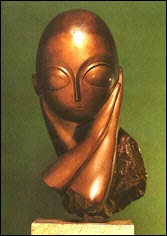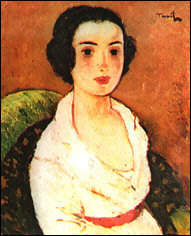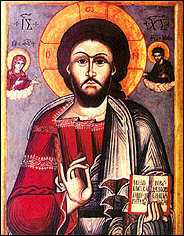 ART ART |
Unfortunately, despite the high level of education of the Romanians, the attention paid to plastic arts is quite appalling. Being caught between empires and constantly raided by neighboring countries, Romania has mostly concentrated in surviving. Although many monasteries boast beautiful frescoes, a lot of its primitive art has been either been destroyed or robbed. Princely courts have been traditionally busier with war than with art. It is no surprise that not too many artists have come out of Romania. However Constantin Brancusi is the exception to the rule.
Constantin Brancusi is the true precursor of abstract sculpture and one of the great art geniuses of the XX century. Born in Romania to a peasant family, his parents died when he was only 10 years old. His extraordinary artistic skills were awarded with a scholarship in Paris. At that time he was so poor he had to do most of the trip by foot and he even had to sell his watch to finish his voyage. Disciple to Rodin and Amedeo Modigliani, Brancusi was able to transform the elegant elongated shapes of the latter into into sculptures. Mademoiselle Pogany remains one of the most exquisite masterworks of this century. Exiled in Paris he was declared persona non grata by the communist regime. Brancusi died in exile. Although most of his work is abroad, Romania holds some of his primitive works, as well as some of his late masterpieces such as the Kiss or the Endless Column.
 Museums Museums |

The National Museum of Art in Bucharest, holds contemporary treasures of Romanian Art. However, it is in pretty bad state, with poorly illuminated rooms, and almost no means. An interesting collection of Orthodox icons can be found in its premises. It is particularly interesting the collection of icons painted on glass, a Romanian particularity. Paintings of some of the most important artists of this country can also be appreciated in its galleries: Grigorescu, Palladi, Tonita
The Royal Palace in Bucharest was transformed after WW II into Romania's National Museum of Art. Although it contains large collections of European art and numerous Romanian and foreign masterpieces, it has been closed to the public since the Revolution, only organizing punctual exhibitions.
Probably the best way is to see art in Romania by leaving Bucharest. The old Saxon city of Sibiu in Transilvania holds one of the best art collections in Romania, the Brückenthal Museum. Once the palace of Baron Brückental, a diplomat and art collector, this beautiful baroque palace houses engravings by Rubens and Dürer, Transylvanian paintings from the XV century and medieval polychrome statues of high quality and execution. Selected pieces of furniture, porcelains and an interesting collection of Romanian artists: the impresionist Grigorescu, or the lesser known but just as interesting Toniza, make this collection a precious jewel.
The Museum of Art of Craiova (Oltenia) also
holds a small but quite representative collection
of Romanian art. The museum has the honor to dedicate
one of its chambers to Constantin Brancusi, the
well known sculptor who was born near this city.
Among others Madmoiselle Pogany and the Kiss can
be contemplated. Works by the Nabis artist Pallady,
follower of Matisse, the ubiquitous Grigorescu or
the orgininal Tonita can be contemplated in this
small but well kept museum which also houses a small
collection of Orthodox icons. |

The Banffy Palace, a beautiful XVII building in the old Hungarian city of Cluj houses the Art Museum of this city. A visit through its excellently restored galleries and well illuminated rooms is an excellent introduction to Romanian art. From Gothic altar pieces to the most innovative modern art pieces, the Banffy Palace is a must for those travelling in Transylvania.
 Monasteries Monasteries |
Curtea de Arges in Wallachia, used to be the capital city of this old principality. To testify it, the Princely Church was built in 1352. It is famous for its Byzantine frescoes full of color and movement. It is presently being restored. The Episcopal Church (1512-17) was built by King Besarab I, also known as Besarab Black Heart, the founder of Walaquia. Its original spiral towers and its profuse decorations outside, combined with an excellent sense of architectural harmony set it apart from the rest of the monasteries in Romania. The inside is thoroughly decorated with neo-Byzantine frescoes executed in the XIX century by the French Lecomte de Noüy, Master Restorer of Notre Dame of París. This church is probably better known for the legend of Manole, a sad story of the architect who had to sacrifice his wife in order to complete the construction of the monastery.
In the Valley of the Olt river lays the Monastery of Cozia. Its construction was ordered by the grandfather of Vlad the Impaler, King Mircea the Old. It is a clear example of the primitive Wallachian style. The church is profusely decorated with excellently well preserved frescoes. These paintings still conserve today the full vibrancy of its old colors. Some of the representations can be as naïf as hairy prophets or angels with several pairs of wings covered by eyes.
The monastery contains a museum in rather bad shape, but it is worth the visit, since it houses some icons considered works of art.

The Monasteries of Southern Bucovina in the region of Moldavia are rightly acclaimed as masterpieces. Having been called the Sistine Chapel of Orthodox art UNESCO declared them a World Heritage site. Located in the northernmost corner of Moldavia, these monasteries were erected by King Stefan the Great to commemorate each of his victories against the Ottomans. They were fully painted with biblical images to illustrate the sacred teachings to illiterate peasants and armies while waiting for battle. Some of these monasteries' frescoes are painted in the outer walls, and despite the passage of time and rigors of climate, they have kept the intensity of colors and the strength of their paintings intact. Each monastery is unique, but the green paintings of Sucevita, the red ones of Humor and the blue tones of Voronet cannot but impress the visitor. |

